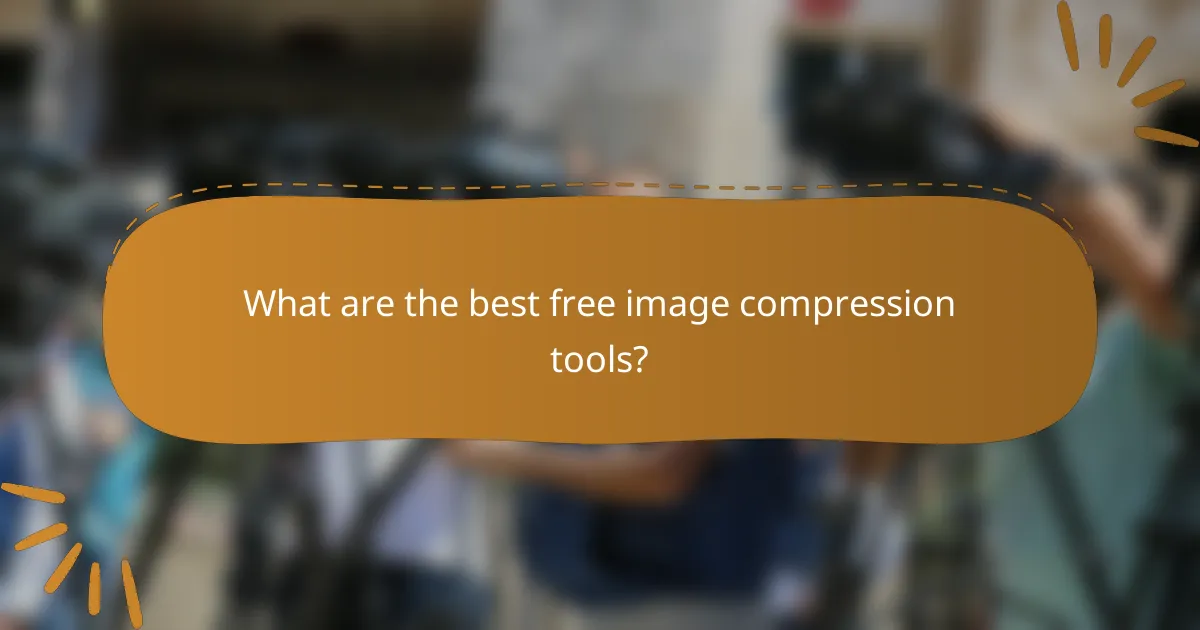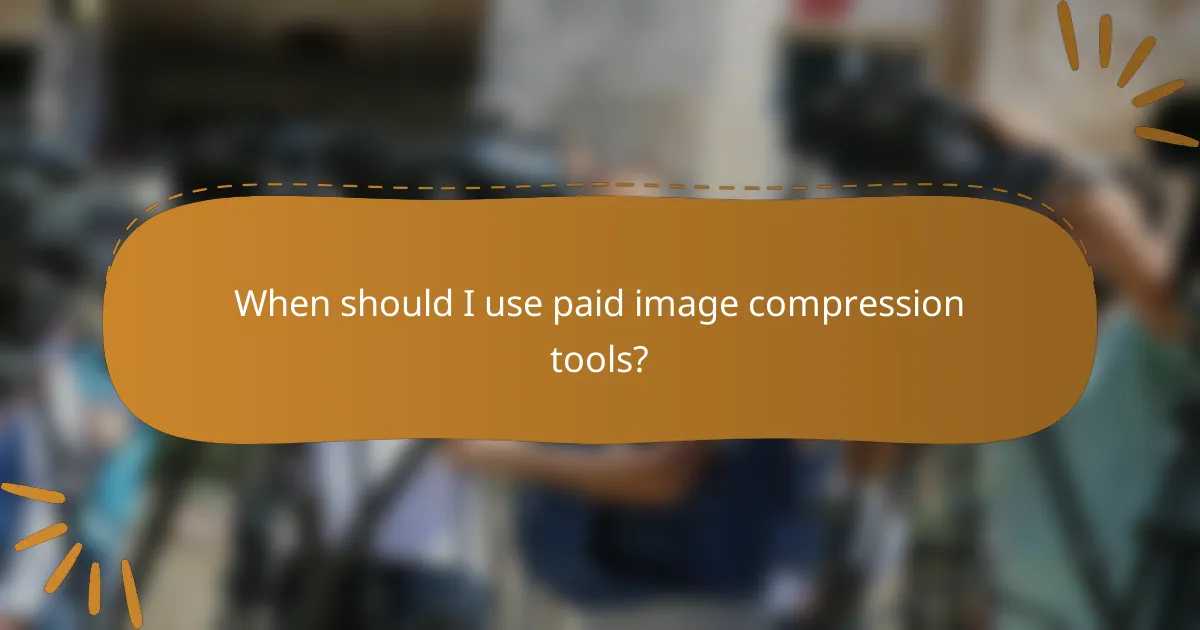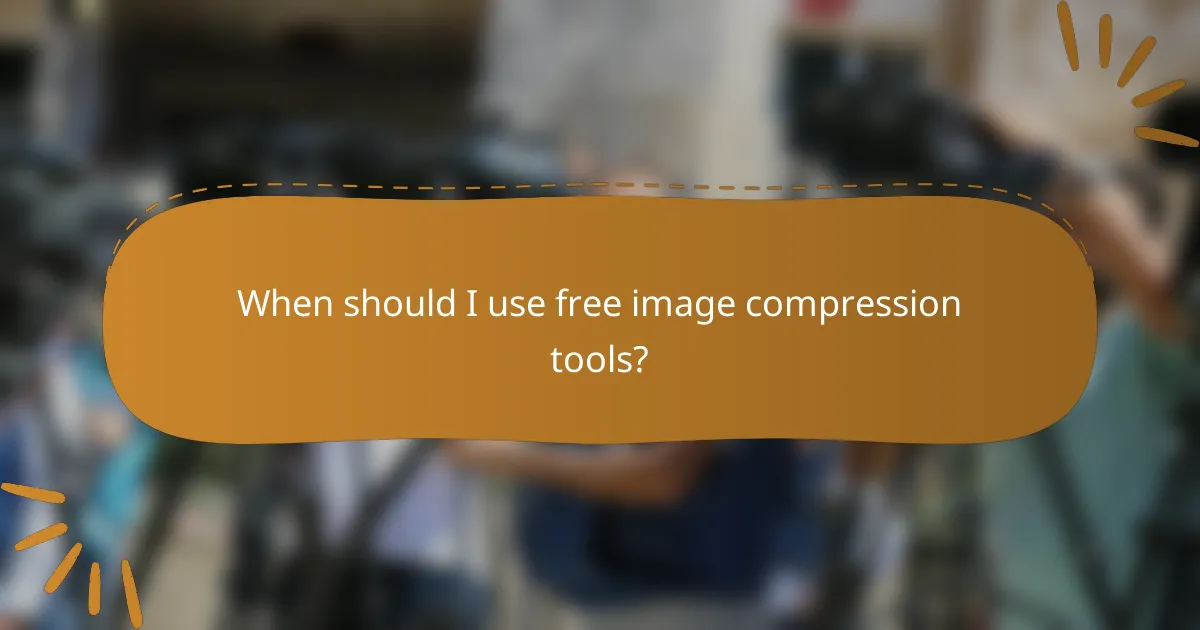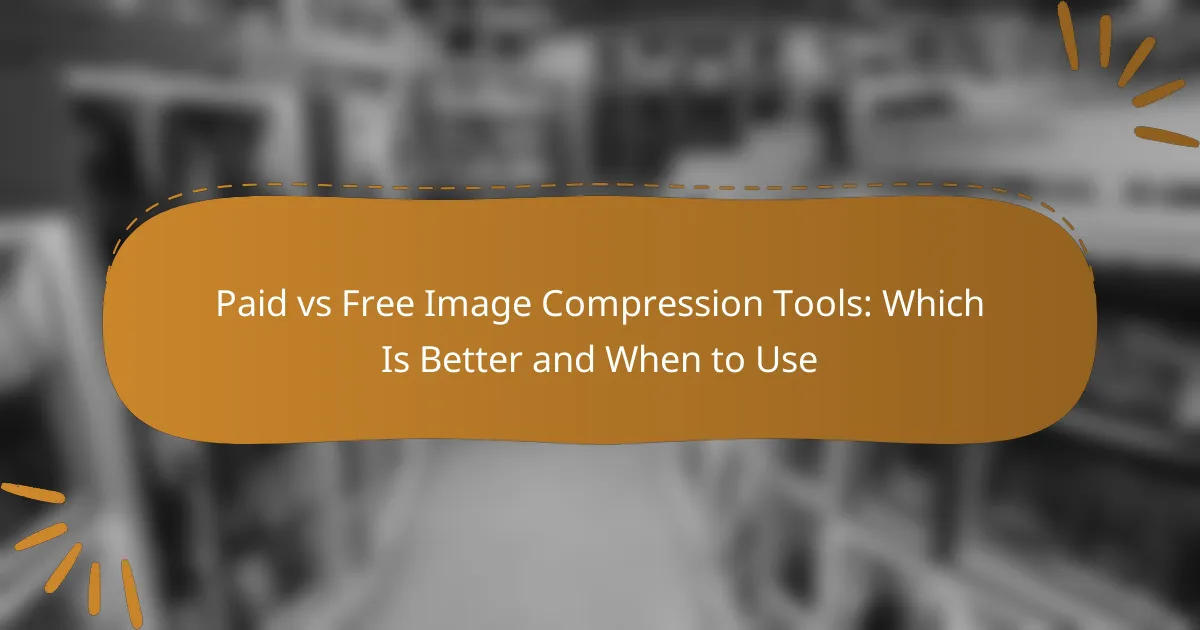When it comes to image compression, choosing between paid and free tools can significantly impact your workflow and output quality. Paid tools typically offer advanced features, superior quality, and reliable support, making them suitable for professionals and businesses. In contrast, free tools can effectively reduce file sizes for casual users, ensuring optimal web performance without major quality loss. Understanding your specific needs will help you determine which option is best for your image optimization tasks.

What are the best paid image compression tools?
The best paid image compression tools offer advanced features, higher quality output, and better support compared to free options. These tools are ideal for professionals or businesses that require consistent performance and reliability in their image optimization processes.
Adobe Photoshop
Adobe Photoshop is a powerful image editing software that includes robust compression capabilities. Users can save images in various formats while adjusting quality settings to balance file size and visual fidelity.
Photoshop’s “Save for Web” feature allows for precise control over compression levels, making it suitable for web use. However, it requires a subscription, which may not be ideal for casual users.
ImageOptim
ImageOptim is a user-friendly application designed for Mac users, focusing on lossless compression. It removes unnecessary metadata and optimizes images without sacrificing quality.
This tool supports various formats and is particularly effective for web developers looking to speed up page load times. The one-time purchase cost is reasonable for those who frequently handle image files.
TinyPNG Pro
TinyPNG Pro is an online service that specializes in compressing PNG and JPEG images while maintaining transparency and quality. It allows users to upload images in bulk, making it efficient for larger projects.
With a subscription, users gain access to additional features such as API integration and enhanced support. This is beneficial for businesses that require seamless image optimization within their workflows.
Kraken.io
Kraken.io is a versatile image optimization tool that offers both lossless and lossy compression options. It supports a wide range of formats and provides a web interface as well as an API for integration into other applications.
Its subscription plans cater to different needs, from casual users to larger enterprises. Kraken.io also includes features like image resizing and optimization for faster loading times, making it a strong choice for web developers.
CompressJPEG
CompressJPEG is a straightforward online tool that allows users to compress JPEG images quickly. It offers a simple drag-and-drop interface, making it accessible for users of all skill levels.
While it has a free version, the paid option provides higher compression rates and additional features like batch processing. This is particularly useful for users who need to optimize multiple images efficiently.

What are the best free image compression tools?
The best free image compression tools provide effective ways to reduce file sizes without significantly sacrificing quality. These tools are ideal for users looking to optimize images for web use, ensuring faster load times and improved performance.
GIMP
GIMP is a powerful open-source image editing software that includes robust compression features. Users can save images in various formats while adjusting quality settings to achieve desired file sizes. It’s suitable for those who need advanced editing capabilities alongside compression.
To compress an image in GIMP, open the file, select ‘Export As,’ and choose a format like JPEG or PNG. Adjust the quality slider to find a balance between size and visual fidelity.
JPEGmini
JPEGmini specializes in compressing JPEG images while maintaining high quality. It uses a unique algorithm that reduces file sizes significantly, often by up to 80%, without visible loss in quality. This tool is particularly beneficial for photographers and web designers.
JPEGmini offers both a free version with limitations and a paid version for more extensive use. Users should consider their needs when choosing between the two options, especially if they handle large batches of images regularly.
Optimizilla
Optimizilla is a user-friendly online tool that allows for the compression of both JPEG and PNG files. It combines lossy and lossless compression techniques, giving users control over the quality and size of their images. This flexibility makes it suitable for various applications.
To use Optimizilla, simply upload your images, adjust the quality settings, and download the compressed files. It’s a quick solution for users needing to optimize images for websites or social media.
Compressor.io
Compressor.io is another effective online image compressor that supports JPEG, PNG, GIF, and SVG formats. It offers both lossy and lossless compression options, allowing users to choose based on their quality requirements. This tool is ideal for web developers looking to enhance site performance.
Using Compressor.io is straightforward: upload your image, select the compression type, and download the optimized file. Users should be aware that lossless compression may not yield as significant size reductions as lossy options.
ImageResize.org
ImageResize.org provides a simple interface for resizing and compressing images online. Users can upload images and choose compression settings, making it easy to reduce file sizes for faster uploads. This tool is particularly useful for quick adjustments without needing software installation.
To compress an image, visit the site, upload your file, and select the desired output size and quality. This tool is great for casual users who need a fast and efficient way to optimize images for personal or small business websites.

When should I use paid image compression tools?
Paid image compression tools are ideal when you need superior quality, advanced features, or bulk processing capabilities. They often provide better optimization, faster processing times, and additional functionalities that free tools may lack.
For professional photography
Professional photographers should consider paid image compression tools to maintain the highest image quality while reducing file sizes. These tools often support lossless compression, ensuring that the integrity of the images is preserved for prints or high-resolution displays.
Additionally, many paid options offer batch processing, allowing photographers to compress multiple images simultaneously without sacrificing quality. This can save significant time when working on large projects.
For bulk image processing
If you frequently handle large volumes of images, paid compression tools can streamline your workflow. They typically offer features like batch processing and automation, which can significantly reduce the time spent on repetitive tasks.
Look for tools that allow you to set compression parameters in advance, so you can apply consistent settings across all images. This ensures uniformity while saving you from manual adjustments for each file.
For advanced editing features
Paid image compression tools often come with advanced editing features that free tools may not provide. These can include options for adjusting image dimensions, applying filters, or integrating with other software for a more comprehensive editing experience.
When choosing a tool, consider whether it offers features like color correction or metadata management, which can enhance your workflow and improve the final output. Investing in these capabilities can be beneficial for professionals who require more than just basic compression.

When should I use free image compression tools?
Free image compression tools are ideal for users who need basic functionality without financial commitment. They work well for quick tasks and personal projects, offering sufficient quality for non-commercial use.
For personal projects
Free image compression tools are perfect for personal projects like photo albums or social media posts. They allow you to reduce file sizes without significant quality loss, making it easier to share images online.
Popular options include TinyPNG and JPEG-Optimizer, which can handle various formats and are user-friendly. These tools typically offer straightforward drag-and-drop interfaces, making them accessible even for those with minimal tech skills.
For quick tasks
If you need to compress images quickly, free tools are often the fastest solution. They usually require no installation and can be accessed directly through a web browser, allowing for immediate use.
For instance, if you have a few images to optimize for a website, you can complete the task in just a few minutes. However, keep in mind that batch processing may be limited, so for larger sets of images, you might need to compress them in smaller groups.
For small businesses
Small businesses can benefit from free image compression tools when working with low-volume projects or when budgets are tight. These tools can help maintain website performance by reducing image load times without incurring costs.
While free options may suffice for occasional use, consider the limitations in features and support. If your business grows and requires more advanced capabilities, transitioning to a paid tool may be necessary for better quality and efficiency.

What are the key differences between paid and free image compression tools?
Paid image compression tools typically offer more advanced features, better customer support, and fewer restrictions compared to free options. Free tools may suffice for basic tasks but often come with limitations that can affect quality and usability.
Features and capabilities
Paid image compression tools generally provide a wider range of features, including batch processing, advanced algorithms, and customizable compression settings. These tools often support various file formats and allow for higher quality outputs, making them suitable for professional use.
In contrast, free tools may offer basic compression capabilities with limited options for customization. Users might find that free tools are adequate for personal projects or quick tasks but may not meet the needs of businesses that require high-quality images consistently.
Customer support
Paid image compression tools usually come with dedicated customer support, offering assistance through various channels such as email, chat, or phone. This support can be crucial for businesses that rely on timely solutions to technical issues.
Free tools often lack robust customer service, leaving users to rely on community forums or FAQs for help. This can lead to frustration if users encounter problems or need guidance on specific features.
File size limits
Free image compression tools often impose strict file size limits, which can hinder users working with larger images or bulk uploads. Many free tools may allow only a few megabytes per file, which can be limiting for professional use.
Paid tools typically offer higher file size limits, enabling users to compress larger images without restrictions. Some services even allow for unlimited file sizes, making them more suitable for extensive projects or high-resolution images.
